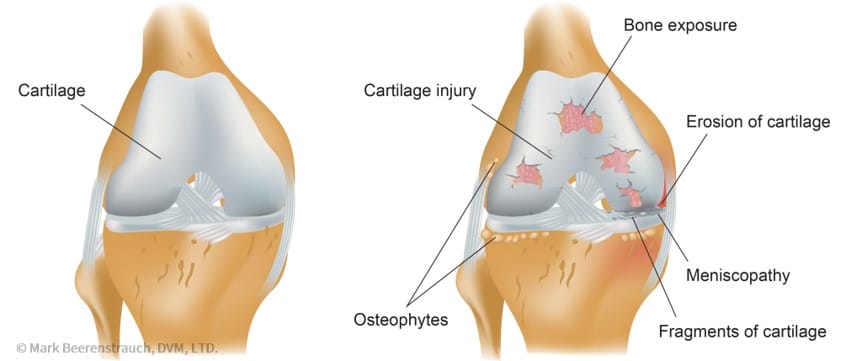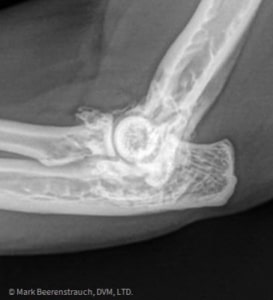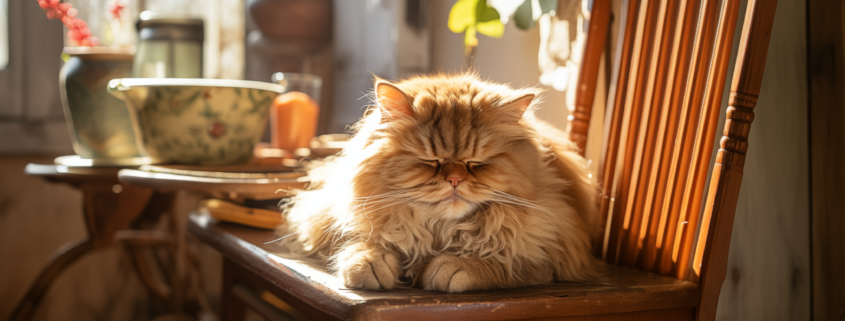Top 5 Signs of Arthritis in Cats
What is arthritis?

This diagram shows the secondary degenerative changes to cartilage with osteoarthritis.
Arthritis, a complex cat issue, entails joint inflammation, causing pain and stiffness. Osteoarthritis (OA), a progressive joint deterioration, describes joint wear and tear. Inside their joints, cats have surfaces covered in a thin layer of smooth cartilage lubricated with fluid, enabling free and frictionless movement. However, arthritis occurs when this smooth surface is damaged, leading to bone rubbing together, causing pain and further damage to the cartilage. Cats aged ten and above often experience OA in at least one joint, making it a prevalent concern for senior feline friends.
What causes arthritis?
The causes of arthritis in cats are multifaceted, including body conformation, excess weight, abnormal joint development, injury history, and previous surgeries. Excess weight and obesity are particularly correlated with OA in felines, making weight management a crucial aspect of arthritis prevention and management. Injuries, fractures, ligament damage, and cartilage erosion contribute to the development of arthritis, emphasizing the importance of understanding and addressing the various factors.
Now, let’s delve into Dr. B’s Top 5 Signs of Arthritis in Cats, each offering valuable insights into identifying and addressing this common issue.
1. Reluctance or Changes in Movement
Cats reluctant to jump up or down from surfaces often signal arthritis. These feline friends might opt for lower surfaces, struggling with heights due to arthritis discomfort.
Dr. B Insight – Cats are unique and very fond of heights. Any change in this behavior can be trouble getting up and progressing arthritis.
2. Change in Behavior
Changes in behavior are subtle yet crucial indicators of arthritis in cats. Increased irritability, grumpiness, or a tendency to avoid interaction could be signs of discomfort. Cats may spend more time alone and alter their social habits; behaviors often misconstrued as typical aging but warrant attention to rule out underlying arthritis.
3. Grooming

An x-ray of a cat’s elbow showing osteophytes and degenerative changes secondary to osteoarthritis.
Grooming habits in cats are sensitive indicators of arthritis. Changes, increases, or decreases in grooming patterns can signify discomfort. Reduced grooming frequency, a matted coat, or overgrooming specific painful joints are all signs to be aware of in your feline companion.
4. Problems with the Litter Box
Arthritic cats may encounter challenges in using the litter box. Discomfort entering or maneuvering inside the box may lead to urinating or defecating outside the box.
Dr. B Insight – Sudden changes in litter box habits, especially in older cats, must be investigated to rule out arthritis or pain-related issues.
5. Limping
Although less common in cats, limping can indicate severe arthritis. Cats may limp or favor specific legs due to arthritis in particular joints.
Dr. B Insight – Even though limping is a common sign of arthritis in dogs, very few cats present with limping as the initial sign. A limping cat often indicates advanced disease.
As we explore these signs, stay tuned for upcoming blogs this month that will delve into various aspects of arthritis, from treatment options to recommended products and expert advice from our Pet Health veterinarians. Understanding these signs early is crucial for effective arthritis management.



